- Home
- Ernest Hemingway
A Moveable Feast Page 2
A Moveable Feast Read online
Page 2
The nineteen chapters of A Moveable Feast published here are based on a typed manuscript with original notations in Hemingway's hand--the last draft of the last book that he ever worked on. The actual manuscript is in the Ernest Hemingway Collection at the John F. Kennedy library in Boston, Massachusetts, the primary repository for all of Hemingway's manuscripts.5 Although this manuscript lacks a final chapter, I believe that it provides a truer representation of the book my grandfather intended to publish.
A number of relatively minor editorial changes were also made to the published edition of A Moveable Feast, changes that I strongly doubt would have been attempted by the editor had she required the author's approval. These changes have been reinstated. The most significant of them, I think, is the changing in many places of Hemingway's use of the second person in the narrative, evident from the very first paragraph of chapter one and then throughout the book (see, e.g., Fig. 1). This intentional and carefully conceived narrative device gives the effect of the author speaking to himself and, subconsciously, through the repetition of the word "you," brings the reader into the story.
A particularly egregious edit was made to the foreword to chapter 17 on F. Scott Fitzgerald. Hemingway's final text (see Fig. 7) reads: His talent was as natural as the pattern that was made by the dust on a butterfly's wings. At one time he understood it no more than the butterfly did and he did not know when it was brushed or marred. Later he became conscious of his damaged wings and of their construction and he learned to think. He was flying again and I was lucky to meet him just after a good time in his writing if not a good one in his life.
But in the posthumous edition, it reads: His talent was as natural as the pattern that was made by the dust on a butterfly's wings. At one time he understood it no more than the butterfly did and he did not know when it was brushed or marred. Later he became conscious of his damaged wings and of their construction and he learned to think and could not fly any more because the love of flight was gone and he could only remember when it had been effortless.6
It is clear that the editors culled this text from an earlier draft (see Fig. 6) discarded by Hemingway, but this kind of editorial decision, which casts Fitzgerald in a less sympathetic light than Hemingway's final version, seems completely unwarranted.
Hemingway had only provided titles for three chapters of his original manuscript: "Ford Madox Ford and the Devil's Disciple," "Birth of a New School," and "The Man Who Was Marked for Death" (see Fig. 4). The titles from the first publication have been retained, except as noted above, for the clarity of the reader familiar with the book. Likewise, I have provided titles for the additional, previously unpublished sketches.
There was a great deal of material that Hemingway wrote for A Moveable Feast that he decided to leave out, acting "by the old rule that how good a book is should be judged by the man who writes it by the excellence of the material that he eliminates." At least ten additional chapters were composed for the book, each in varying stages of completion, and these have been included in this special edition as a separate section after the main text. None of these chapters were finished to the author's satisfaction and must be regarded as incomplete. Some of the chapters were written and rewritten in two drafts, and others are preserved in only a single handwritten first draft. As a corpus, I think that most readers will agree they provide a most interesting supplement to the book.
The chapters of A Moveable Feast do not follow a strict chronological order. Similarly, I have organized the additional chapters with a slightly idiosyncratic logic. "Birth of A New School" comes first because this chapter was already included in the first publication of the book, where the editors had placed it between "Ford Madox Ford and the Devil's Disciple" and "With Pascin at the Dome." Hemingway wrote two different possible endings for this chapter, which were edited and partially conflated by the editors of A Moveable Feast. Both endings are provided here as Hemingway wrote them. Likewise, "Ezra Pound and His Bel Esprit" is material that was published in A Moveable Feast but had been written as a separate chapter, and, in fact, was cut by Hemingway.
"On Writing in the First Person" is next because it is quite different from all of the other pieces. It focuses on writing rather than a particular remembrance, and, as a piece about process, seems more appropriate at the beginning than at the end. While incomplete, it offers insight into the process of writing and pokes fun at the so-called "detective school" of literary criticism. Most young writers write fiction from their own experience but Hemingway, as he intimates in this brief sketch, culled a great deal of material from other firsthand and secondhand sources. For example, he writes about interviewing soldiers from World War I, and his mastery of historical fiction is never more evident than in his novel A Farewell to Arms, where he has recreated the retreat of Caporetto so accurately that one would not believe he had not been at the battle.7
"Secret Pleasures" is a story about Ernest wearing his hair long and deciding with Hadley to grow their hair to the same length. Most likely it is based primarily on the winter of 1922-23, when they were at Chamby sur Montreux, Switzerland, not Schruns, Austria, and is a case where Hemingway has altered the facts to improve the story.8 The sketch, only preserved in a single handwritten draft, is audacious for its intimate portrayal of the author and his wife and recalls certain passages in Hemingway's posthumous novel, The Garden of Eden.9 It gives a particularly vivid impression of Ernest Hemingway as a young professional with one good suit and one pair of dress shoes who needed to observe the social conventions and dress code of his job as a journalist. The length that one cuts one's hair remains a theme that resonates with young people today as they get their start in life. Hemingway conveys the complexity of motivations and assumptions in the simple act of growing his hair out: transitioning to his new bohemian lifestyle as a full-time writer of fiction, saving money both by not cutting his hair and not going out to the fashionable quarter because of his bohemian appearance, how this allowed him to focus on his writing, his journalist colleagues' disdainful impressions contrasted with the completely different cultural associations of long hair for Japanese men, whom Hemingway met at Ezra Pound's studio and whose long, straight black hair Hemingway admired. From this practical and anti-establishment act grows the idea that he and Hadley wear their hair at the same length as a kind of secret pleasure shared between them. Hemingway comically contrasts the scene in Paris with that in Schruns, where the local barber assumes that Hemingway is following the new Paris fashion and, consequently, encourages other customers to take up the style.
"A Strange Fight Club" is a story about a little-known Canadian boxer named Larry Gains and his irregular training at the Stade Anastasie, a dance hall restaurant in a tough part of Paris where fights were held as dinnertime entertainment and the fighters acted as waiters. It is an unusual portrait of Paris life in the 1920s and reveals the pugilistic side of Ernest Hemingway, who enjoyed boxing himself and often covered important fights as a journalist.10 Hemingway, as when he spars with Ezra Pound in his studio, casts himself as the authority, which he displays to the reader through his careful assessment of Larry Gains's inexperienced moves.
"The Acrid Smell of Lies" is an unflattering portrait of Ford Madox Ford, whose breath was "fouler than the spout of any whale." Hemingway's intense dislike of Ford has long puzzled biographers, especially given Ford's often glowing praise in print of Hemingway's writing and the opportunities that Ford gave Hemingway as an assistant editor of The Transatlantic Review.11 According to one theory, their falling out was the result of a dispute over money.12 In this sketch, Hemingway ascribes his "unreasonable antipathy" toward Ford as his own inability to listen to Ford's constant lying.
"The Education of Mr. Bumby" is a sketch preserved in just one handwritten draft, in which Ernest and his son Jack, whose nickname was Bumby, join F. Scott Fitzgerald for a drink at a "neutral" cafe in Paris. The piece adds another example to Hemingway's portrayal of Fitzgerald's problems with drinking and his wife Zelda's
jealousy over his writing. After telling Fitzgerald stories about World War I, Hemingway mentions to Bumby that their friend Andre Masson was damaged by the war but went on to lead a productive life as a painter. Masson served in the Great War for two and a half years until 1917, when he was wounded in the chest and suffered depression afterward. Masson shared with Joan Miro a Paris studio, which Hemingway visited on a number of occasions. Hemingway acquired three forest landscape paintings by Masson, all of which now hang in the Hemingway room at the John F. Kennedy library, and knowing that Masson was deeply affected by the war may explain something of their haunting effect.13
"Scott and His Parisian Chauffeur" is more a story about F. Scott Fitzgerald than about Paris--it takes place in America after a Princeton football game that the Fitzgeralds and Hemingways attended together in the fall of 1928. One can see why Hemingway decided to leave it out as it falls outside the general chronological parameters of the book. However, the black humor and automotive theme make the sketch a fine sequel to Ernest's earlier chapter on the drive with Fitzgerald from Lyon to Paris in his hoodless Renault, amplifying Hemingway's portrayal of "Scott's complicated tragedies, generosities and devotions."
To judge from the manuscripts (see, e.g., Fig. 5), the most difficult part of writing A Moveable Feast for Ernest Hemingway was coming to terms with his betrayal of Hadley with Pauline and the end of that first marriage. In a way this would have been a logical ending to the book, and one can see why Mary Hemingway decided on it for the ending. However, Hemingway, after writing a chapter about it, included in this edition as "The Pilot Fish and the Rich," decided that it was not the ending he wanted since he considered his marriage to Pauline a beginning, and this ending clearly left the heroine of the book, Hadley, abandoned and alone. What is worse is that only a part of "The Pilot Fish and the Rich" was incorporated into the last chapter of A Moveable Feast in the 1964 edition. The remorse that Hemingway expresses and the responsibility that he accepts for the breakup, as well as "the unbelievable happiness" that he had with Pauline, was cut out by the editors. For the first time, readers of this edition have the full text to consider as Hemingway wrote it. The extensive edits Mary Hemingway made to this text seem to have served her own personal relationship with the writer as his fourth and final wife, rather than the interests of the book or of the author, who comes across in the posthumous first edition as something of an unknowing victim, which he clearly was not (see also Fig. 5).
"Nada y Pues Nada" was written by Ernest Hemingway over three days, from April 1-3, 1961, as a possible final chapter for the book. It is the last demonstrable sustained piece of writing that Hemingway did for the book and is only preserved in a single handwritten manuscript (see Fig. 8). It is as much a reflection of the author's state of mind at that time, only three weeks before he attempted suicide, as it is a contribution to the book. His commitment to his work despite his failing health is remarkable, especially amid the paranoia and severe state of depression that he was facing. Writing, as he had done before in better times, that he was born to write "and had done and would do again" must have been difficult knowing that his writing was not going well and had not been for some time. In the final sentence, he writes that his memory has been tampered with, likely a reference to his recent visit to the Mayo clinic for shock therapy treatment, and that his heart no longer exists. As Hemingway's Spanish Civil War-time friend Antoine de Saint Exupery observed in his book, Le Petit Prince, it is only with the heart that we can see rightly, as the essence of things is not visible to the eye. Hemingway's expression of despair is a sad portent of the end for him, which came by his own hand less than three months later.
In a letter written to Charles Scribner, Jr., on April 18, 1961, but never mailed, Hemingway writes that he is unable to finish the book as he had hoped and suggests publishing it without a final chapter.14 He mentions that he has been trying to write an ending for over a month. The false starts and endings included in the Fragments section of this volume probably belong to this time. He also provides a long list of tentative titles for A Moveable Feast. Hemingway had a habit of writing out lists of possible titles for his books from as early as his 1920s collection, in our time.15 Some names were frivolous and some were serious, and he often liked to say that the Bible was the best source for finding titles.16 At first glance, the list of titles Hemingway drew up at this time seems awful and may be an indication of how much his mind was deteriorating. They include: The Part Nobody Knows, To Hope and Write Well (The Paris Stories), To Write It True, Good Nails Are Made of Iron, To Bite On the Nail, Some Things As They Were, Some People and The Places, How It Began, To Love and Write Well, It Is Different In The Ring, and, my personal favorite, How Different It Was When You Were There.
The title that he tentatively settled on was The Early Eye and The Ear (How Paris was in the early days). This last title sounds a bit like a medical textbook that could have belonged to his father. In seriousness, though, I think that Hemingway was trying to get at what he believed were key facets of his writing technique with this title. The eye, a term usually used in the connoisseurship of fine art, draws an interesting comparison between writing and painting, a subject that Hemingway discusses in A Moveable Feast, especially his learning from the paintings of Cezanne.17 Hemingway first developed his eye, his ability to discern the gold from the dross and turn his observations into prose, in Paris in the twenties. The ear, which we think of as more pertinent to musical composition, is clearly important to creative writing. Hemingway's writing typically reads well when spoken aloud. When complete, his writing is so tight that every word is integral, like notes in a musical composition. In his early years in Paris, he learned about the value of rhythm and repetition in writing from Gertrude Stein and, especially, James Joyce, whose masterpiece, Ulysses, published by Sylvia Beach at Shakespeare and Company, is an extraordinary virtuoso display of English prose that comes alive when read aloud.18 The Early Eye and The Ear gets at the need to hone your craft, something Hemingway truly believed in and worked at all his life. It implies talent, for you must have a good eye and a good ear to begin with if you are to be successful, but it also suggests that you need experience to develop your abilities as a writer, and Paris at that time was for Ernest Hemingway the perfect place to do this. Indeed, many of the handwritten first-draft manuscripts of A Moveable Feast are extremely clean and serve as remarkable and poignant testimonies to Hemingway's talent (see Figs. 2-3), even in his final years. The deathless prose appears on the page fully formed like the goddess Athena born from the head of Zeus.
The final title of the book, A Moveable Feast, was chosen by Mary Hemingway after the author's death. It does not appear anywhere in the manuscript but was suggested to her by A.E. Hotchner, who recalls Ernest mentioning the phrase to him at the Ritz Bar in Paris in 1950.19 The choice of spelling follows Hemingway's idiosyncratic preference to retain the "e" in words ending in "ing" and formed from verbs that ended in "e." It adds the imprint of the author, and the "ea" in Moveable also makes a pleasant visual repetition with the "ea" in Feast. In his foreword, Patrick Hemingway sheds light on the historical use of the term by my grandfather in his writing and at home.
Whether you are reading it for the first time or coming back to it like visiting with an old friend, A Moveable Feast retains a freshness that is remarkable. Recently, I was in Paris to bring a marble portrait bust of the Greek historian Herodotus from the Metropolitan Museum of Art to the Louvre for an exhibition on Babylon from the third millennium B.C. to the time of Alexander the Great and on into myth, when that great city became a place of legend and a biblical symbol of decadence. I was reminded of F. Scott Fitzgerald's fine short story, "Babylon Revisited," where he describes Paris as a place of excess, endless parties, and lurid decadence at the time that Hemingway first knew him in the mid-1920s, and how different Paris was for Fitzgerald at the end of the decade, during the Great Depression, when his own career was on a downward turn.20 There were not many Americans in P
aris during my recent visit, with the weak dollar and current economic difficulties at home. While for Hemingway in the 1920s "exchange was a beautiful thing," the pendulum has swung and American expatriate life in Paris is no longer cheap.21 Paris was for me (and my grandfather rightly states each person's experience is different) an inspiring and vital place of beauty and light, and history and art.
For my grandfather, who was just starting out in those early years, Paris was simply the best place to work in the world, and it remained for him the city that he loved most. While you will not find goatherds piping their flocks through the streets of Paris anymore, if you visit the places on the Left Bank that Ernest Hemingway wrote about, or the Ritz Bar or Luxembourg Gardens, as I did with my wife recently, you can get a sense of how it must have been. You do not have to go to Paris to do this, though; simply read A Moveable Feast, and it will take you there.
Sean Hemingway
1
A Good Cafe on the Place St.-Michel
Then there was the bad weather. It would come in one day when the fall was over. You would have to shut the windows in the night against the rain and the cold wind would strip the leaves from the trees in the Place Contrescarpe. The leaves lay sodden in the rain and the wind drove the rain against the big green autobus at the terminal and the Cafe des Amateurs was crowded and the windows misted over from the heat and the smoke inside. It was a sad, evilly run cafe where the drunkards of the quarter crowded together and I kept away from it because of the smell of dirty bodies and the sour smell of drunkenness. The men and women who frequented the Amateurs stayed drunk all of the time or all of the time they could afford it; mostly on wine which they bought by the half-liter or liter. Many strangely named aperitifs were advertised, but few people could afford them except as a foundation to build their wine drunks on. The women drunkards were called poivrottes which meant female rummies.

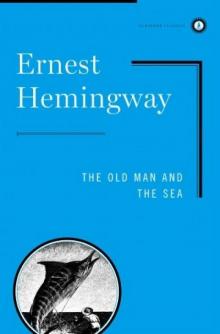 The Old Man and the Sea
The Old Man and the Sea Green Hills of Africa
Green Hills of Africa The Sun Also Rises
The Sun Also Rises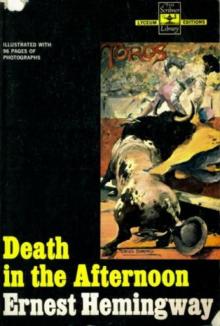 Death in the Afternoon
Death in the Afternoon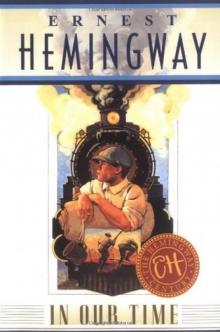 In Our Time
In Our Time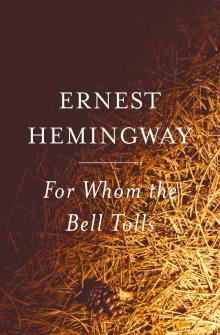 For Whom the Bell Tolls
For Whom the Bell Tolls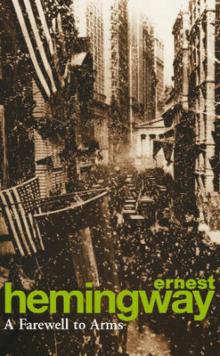 A Farewell to Arms
A Farewell to Arms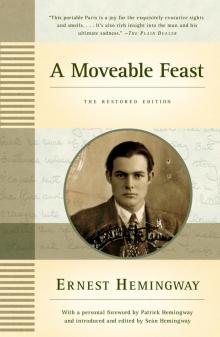 A Moveable Feast
A Moveable Feast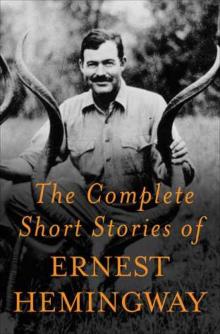 The Complete Short Stories of Ernest Hemingway
The Complete Short Stories of Ernest Hemingway Big Two-Hearted River
Big Two-Hearted River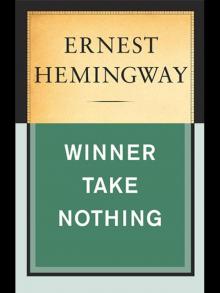 Winner Take Nothing
Winner Take Nothing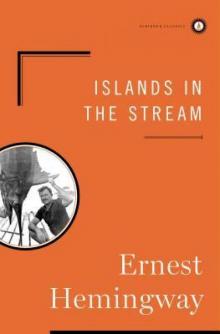 Islands in the Stream
Islands in the Stream To Have and Have Not
To Have and Have Not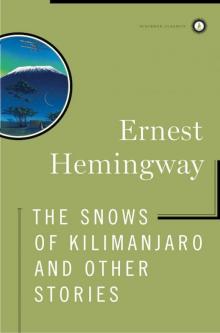 The Snows of Kilimanjaro and Other Stories
The Snows of Kilimanjaro and Other Stories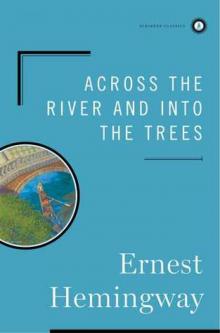 Across the River and Into the Trees
Across the River and Into the Trees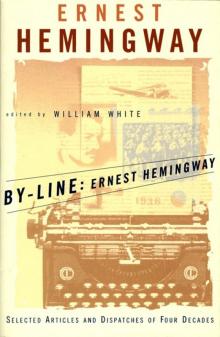 By-Line Ernest Hemingway
By-Line Ernest Hemingway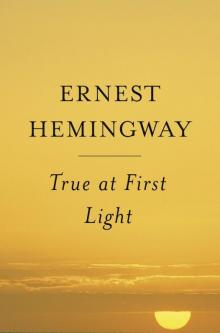 True at First Light
True at First Light Men Without Women
Men Without Women The Nick Adams Stories
The Nick Adams Stories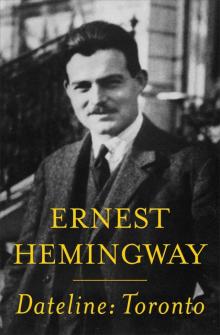 Dateline- Toronto
Dateline- Toronto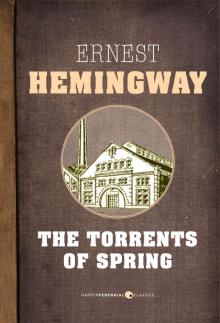 The Torrents of Spring
The Torrents of Spring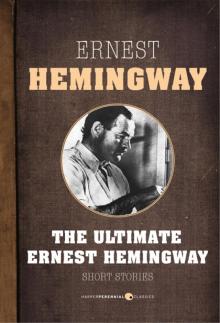 Short Stories
Short Stories